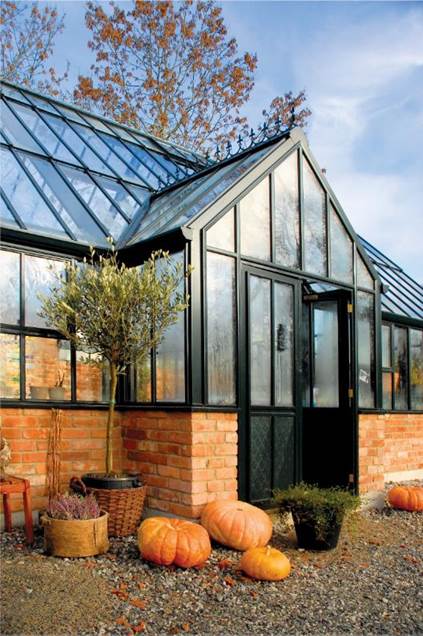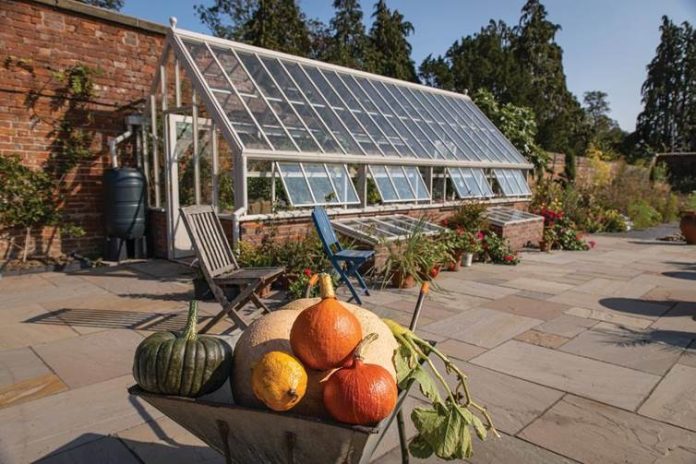It’s spring here in Illinois, and it’s been unusually (or, “unseasonably” as the weatherperson would say) cold and wet. While we await warmer temperatures to get out and garden, it’s never too early to start thinking way ahead — into fall.
When it comes to pumpkins, Illinois is the King — consistently growing more pumpkins than anywhere else in the U.S. But if you want to bring some of the magic of the pumpkin patch home, it’s totally doable (and we’ve done it, but it’s been a while).
The folks at Hartley Botanic — a globally recognized greenhouse and glasshouse maker — have served up some tips for growing pumpkins in a greenhouse, and they’ve done it by taping into decades of experience: they’ve been making greenhouses in the UK since 1938. Get inspired to grow some pumpkins that will be ready in time for Halloween with insight from the Hartley Botanic crew below, then check out the Hartley Magazine for a host of great gardening tips!

A short overview of pumpkin types and varieties…
Pumpkins are part of the Cucurbit family that also includes squash, marrows, cucumbers, melons, and even the more exotic loofah. There are two different types of squash – summer and winter. Pumpkins are considered winter squashes. They mature mid to late autumn and need a long season (80-110 days) to ripen the fruit and harden the skin. The extended growing time will pay off, however, as they will keep for many months.
Pumpkins to Try
- Atlantic Giant: The one to grow if you want a record-breaking monster – this one can reach 800 pounds.
- Magic Lantern: Perfect for Halloween carving, it produces 16 -24 pound pumpkins on vigorous compact vines.
- Naked Bear: Combines a great baking 2- 4-pound pumpkin with no-hull seeds for snacking.
- Lil’ Pump-Ke-Mon: This small 1-pound white pumpkin shows off bright orange stripes along its ribbing – just right for autumn decor, and a good size for individual servings.
- Jill Be Little: A prolific half-pound pumpkin, both decorative and edible, that keeps for a long time and is highly disease resistant.
From Seed to Germination
Unless you are aiming for a giant pumpkin – which you would limit to one per vine — you should plan on 3-4 pumpkins per plant depending on the variety. That way you’ll ensure a crop ready for carving in October, and hopefully, a few more to spare for soups, pies, and risottos too.
Begin to sow your pumpkins inside your warm greenhouse 3-4 weeks before your last frost date, which will depend on your regional USDA Zone. Potting soil temperature for germination should be around 65-75 degrees.
Fill several individual 2-inch across pots with a good quality seed compost. Use a dibber to make one hole in the center of each pot about 1 inch deep. Place one seed into each hole. Plant seeds on their side, rather than flat in the hole; this can help prevent them from rotting. Cover with soil and water gently with slightly tepid water. Leave in a sunny part of the Greenhouse. Water if the soil surface feels dry to the touch. Do not overwater.
Check the seeds daily as they are very quick to germinate — just 5-10 days. If it is too warm, the stems will stretch very quickly making them top-heavy. Once they have germinated, move to cooler conditions, such as the Greenhouse bench or a cold frame to grow on. Keep a watch out for slugs and snails as these will quickly devour young pumpkin plants. Allow two or three sets of leaves to form and keep the plants moist but not overly wet. When you can see the roots through the bottom of the pots, they are ready to plant out.
Planting out
When all danger of frost has passed, and soil temperatures outdoors have reached at least 60 degrees, the pumpkins can be planted outside. This timing is important as these tender plants will be quickly killed by a late frost. Space the trailing varieties at least 4-6 feet apart between rows or hills and smaller varieties about 3-4 feet apart. The plants themselves can be placed as little as a foot apart or up to six feet between, depending on the variety. Pumpkins, like other squash, are subject to fungal diseases, so they should not be crowded, but have plenty of air and space to grow.
Dig one or two plants into the very top of a mound of rich soil or place them individually into a large planter. Feed with a quality organic fertilizer of your choice. Feed occasionally throughout the season to encourage good leaf color and also fruit growth. Protect from slugs and snails, and keep them well-watered. In a growing season, pumpkins will consume 15-20 inches of water. Keep track of rainfall, and supply additional irrigation if needed.
Pumpkins need good fertile soil. They can be grown on an old compost pile as long as it is mature. New manure heaps will be too ‘hot’ in terms of temperature and richness so the leaves may scorch. Alternatively, dig a 1-foot-deep hole with a similar diameter and backfill with some garden compost or well-rotted manure. Then shovel a half mix of soil and compost into the hole and form a mound on top. The plants can then be planted at the top of the hill. Sometimes it helps to support the stem by gently tying it to a short stake at this stage. One problem after planting is wind battering the young plants, shredding the leaves, and snapping the stems. As the plants grow, you can remove the stem supports.
Pollination
Pumpkins have separate male and female flowers on the same plant. The male flowers open first. Then the female flowers arrive with tiny pumpkins behind the flower. They need bumblebees, honey bees, or their own squash bees to pollinate them. They may also be visited by other solitary flyers, such as mason bees. They pick up pollen on their bodies and transfer it to the female flowers which are rich in nectar as they move from flower to flower. But you can also hand pollinate. Pick an open male flower. Remove the pollen-rich stamen from the male flower and rub it over the central sticky stigma inside the female flower to transfer the pollen.
Pumpkins are sometimes a bit shy to flower at first until they get going. For long vines, leave the trailing stems to grow naturally for 10-15 feet. Then you could nip the end out. This will encourage side shoots to form along the stem. These will produce a lot more flowers. Once this happens you should start to see one or two fruits setting. If you are aiming for large pumpkins, then cut off the growing tip about two or three leaves beyond the fruit. Remove the growing tips of other side shoots as well to encourage all the plant’s energy into the one or two fruits you have picked out.
Harvest time
The pumpkins are ready when the color is fully developed and they are firm and ripe. That may not be until late in autumn. Often the vines may die back before the pumpkins are ready to harvest. Leave the fruits where they are until they have colored up more and been touched by the autumn sun, as long as night temperatures stay above 28 degrees. Harvest your pumpkins with an inch or more of stem, cure them for a few days in a warm spot – perhaps they can return to the greenhouse again.
Learn more: hartley-botanic.com/magazine




